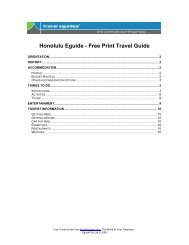Australia Eguide - Travel Guides
Australia Eguide - Travel Guides
Australia Eguide - Travel Guides
You also want an ePaper? Increase the reach of your titles
YUMPU automatically turns print PDFs into web optimized ePapers that Google loves.
90<br />
member of the Finness exploration party which passed through here and named the<br />
various features. He was fortunate to be able to live on in history by having his name<br />
given to such a memorable and beautiful location. Litchfield was originally a mining<br />
area, from the late nineteenth century until the 1950s. The minerals found here are copper<br />
and tin. When mining was no longer profitable, the area became a pastoral property. It<br />
was only in 1986 that it was proclaimed as a National Park. Admission to the park is free,<br />
but there is a fee for camping.<br />
Waterfalls are some of the main attractions, the most noteworthy being Wangi Falls,<br />
Buley Rockhole, Florence Falls, Tolmer Falls and Tjaynera Falls. There are also groups<br />
of termite mounds (‘ant hills’), such as you will find throughout the Territory, and one in<br />
particular resembles the tombs in a graveyard. The ‘Lost City’ is a sandstone formation<br />
resembling a city with fortifications, statues and inhabitants, but it is not easily accessible<br />
without a four-wheel-drive vehicle. There is no accommodation available within the park,<br />
but camping is permitted, for a fee, at designated camping areas. Accommodation is<br />
available at Batchelor and tours of the park are available from Batchelor.<br />
Kakadu<br />
The Kakadu National Park lies some 300 kilometres east of Darwin and is said by some<br />
visitors to be the most beautiful place that they have ever seen. Certainly the escarpment<br />
forming the eastern boundary of the park is impressive, and some of the waterfalls, when<br />
flowing in the Wet, are awe-inspiring.<br />
The route to Kakadu first follows the main road south from Kakadu, and then, after forty<br />
kilometres, turns off east, and soon reaches Humpty Doo. Here you can find Graeme<br />
Gow's Reptile World, a display of snakes and reptiles, including 25 of the world's most<br />
venomous snakes. The road crosses the Adelaide River after a further few kilometres.<br />
This is the place at which there are cruises on the river to see the jumping crocodiles.<br />
Continuing, the Djukbinj National Park is on your left, and then you will come to the<br />
Mary River Crossing, with Mary River Park and, three kilometres on, Bark Hut. A little<br />
further on is the entrance to the Mary River Wetlands, less famous than Kakadu, but<br />
offering plenty of wildlife observation, bushwalking and fishing. There are tours<br />
operating from here, especially bird watching tours, for several rare species are found in<br />
the area, attracted by the year-round water supply. There are also crocodile cruises every<br />
two hours. The scenery is less spectacular than that of Kakadu, but the area has a less<br />
touristic feel to it. Everybody knows about Kakadu, but few know how beautiful the<br />
Mary River Wetlands can be too. Budget accommodation and camping are both available<br />
here.<br />
<strong>Travel</strong>ling on eastwards, you will soon come to the entrance to Kakadu. It is a vast area,<br />
so there are several places to stay and many more which one ought to visit. The<br />
aborigines may have lived in this area for some 50,000 years and there are 5,000 sites<br />
Free from <strong>Travel</strong><strong>Eguide</strong>s.com Online <strong>Travel</strong> Information.<br />
©2008 <strong>Eguide</strong> Pty Ltd




